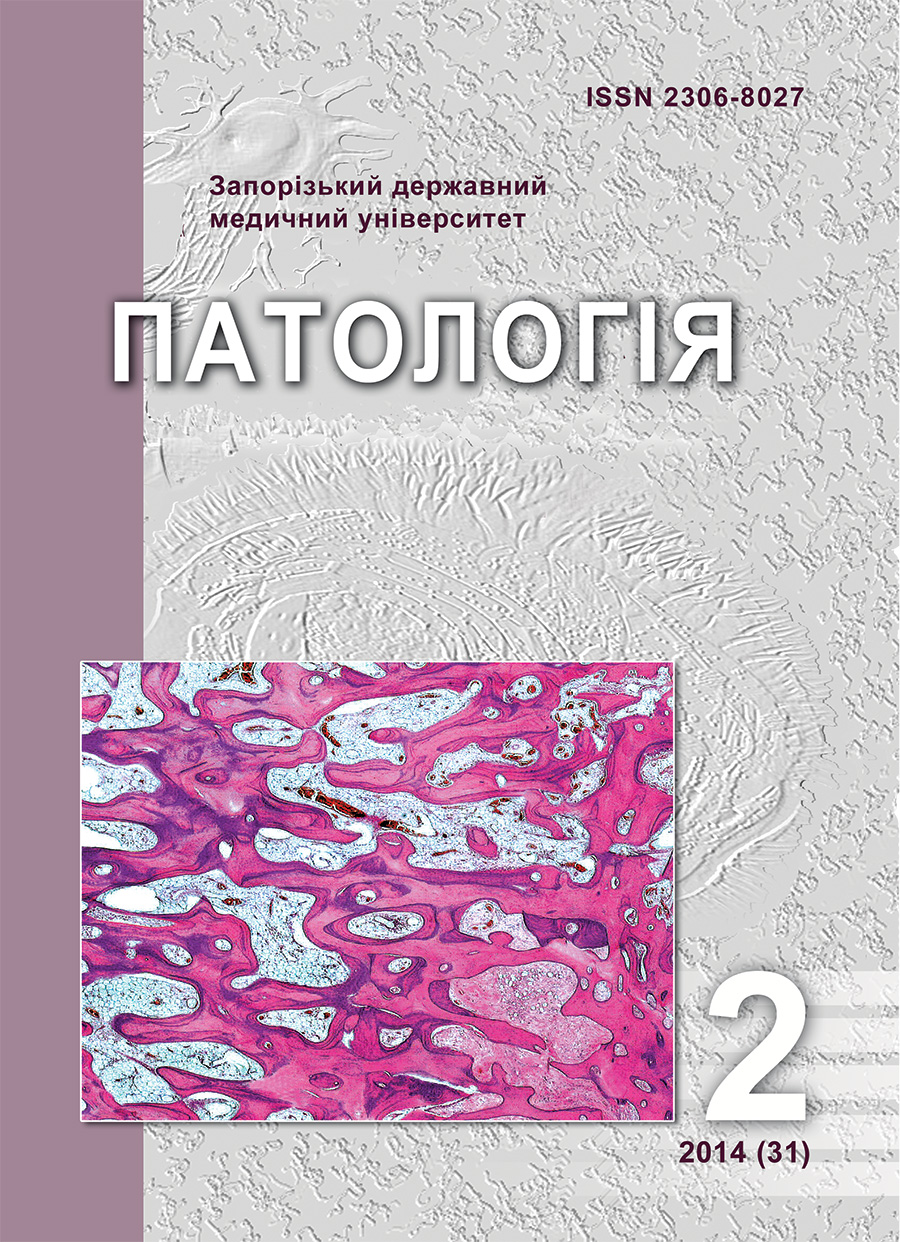Qualitative and quantitative morphological indices of damage and reparation in idiopathic femoral head osteonecrosis in adults
DOI:
https://doi.org/10.14739/2310-1237.2014.2.28591Keywords:
Femoral Head Necrosis, Pathology, Morphology, StatisticsAbstract
Aim. Idiopathic aseptic femoral head osteonecrosis is one of the diseases which happen often and in most cases lead to permanent disability.
Methods and results. On purpose to establish qualitative-quantitative features and differences between pathomorphological changes and their consequences in comparison groups divided by lesion remoteness, on histotopogfaphic specimens of 30 femoral heads from patients with aseptic osteonecrosis values of parametric and nonparametric indices were investigated.
Conclusion. It was found that aseptic femoral head osteonecrosis is large-focal lesion which persist for years and in overwhelming majority of cases does not lead to complete necrosis replacement. Statistically estimated intergroup differences of some morphological indices of femoral head tissue lesion and reparation indicate that pathological changes gradually progress in the direction of coxarthrosis of average or high degree.
References
Mont, M. A., Zywiel, M. G., Marker, D. R., McGrath, M. S., & Delanois, R. E. (2010). The natural history of untreated asymptomatic osteonecrosis of the femoral head: a systematic literature review. J. Bone and Joint Surg, 92-B (12), 2165–2170.
Malizos, K. N., & Papatheodorou, L. K. (2012). New trends in osteonecrosis of the femoral head. European Instructional Lectures. Ed. G.Bentley. 13-th EFORT Congress. Berlin, 149–161.
Torchynskyi, V. P., & Nirshberg O. Ye. (2013). Paliatyvni operatsii u likuvanni khvorykh na aseptychnyi nekroz holovky stehnovoi kistky [Palliative operations in the management of patients with femoral head aseptic necrosis]. Visnyk ortopedii, travmatolohii ta protezuvannia, (4), 42–48. [in Ukrainian].
Filipenko, V. A., Olinichenko, G. D., Miteleva, Z. M., & Poletaieva, N. Yu. (2013). Rezultaty khirurhichnoho likuvannia aseptychnoho nekrozu holovky stehnovoi kistky na rannihk stadiiakh [The results of surgical management of femoral head aseptic necrosis]. Ortopediya, travmatologiya, protezirovanie, 1, 5–9. [in Ukrainian].
Babis, G. C., Sakellariou, V., Parvizi, J., & Soucacos, P. (2011). Osteonecrosis of the Femoral Head. Orthopedics, 34 (1), 39–48.
Sweet, D. E., Madewell, J. E. (1995). Osteonecrosis. Pathogenesis. Resnick, D. Diagnosis of Bone and Joint Disorders. Philadelphia: Saunders, (Vol. 5), (p. 3445–3494).
Min, B. W., Song, K. S., Cho, C. H., Le, S. M., & Lee, K. J. (2008). Untreated asymptomatic hips in patients with osteonecrosis of the femoral head. Clin. Orthop. Rel. Res., 466, 1087–1092.
Fukushima, W., Yamamoto, T., & Takahashi, S. (2013). The effect of alkohol intake and the use of oral corticosteroids on the risk of idiopathic osteonecrosis of the femoral head. A case-control study in Japan. Bone Joint Journ. 95-B (3), 320–325. doi: 10.1302/0301-620X.95B3.30856.
Zlotorowicz, M., Szczodry, M., Czubak, J., & Ciszek, B. (2011). Anatomy of the medial femoral circumflex artery with respect to the vascularity of the femoral head. J. Bone and Joint Surg. 93-B (11), 1471–1474. . doi: 10.1302/0301-620X.93B11.26993.
Grigorovskij, V. V. (2008). Ostrye travmaticheskie ishemicheskie porazheniya kostej: patogenez, morfogenez, differencial'naya diagnostika [Acute traumatic ischemic lesions of bones: pathogenesis, morphogenesis, differential diagnosis]. Zhurnal Akademii medychnykh nauk Ukrainy, 1, 116–133. [in Ukrainian].
Downloads
How to Cite
Issue
Section
License
Authors who publish with this journal agree to the following terms:
Authors retain copyright and grant the journal right of first publication with the work simultaneously licensed under a Creative Commons Attribution License that allows others to share the work with an acknowledgement of the work's authorship and initial publication in this journal.

Authors are able to enter into separate, additional contractual arrangements for the non-exclusive distribution of the journal's published version of the work (e.g., post it to an institutional repository or publish it in a book), with an acknowledgement of its initial publication in this journal.
Authors are permitted and encouraged to post their work online (e.g., in institutional repositories or on their website) prior to and during the submission process, as it can lead to productive exchanges, as well as earlier and greater citation of published work (SeeThe Effect of Open Access).

